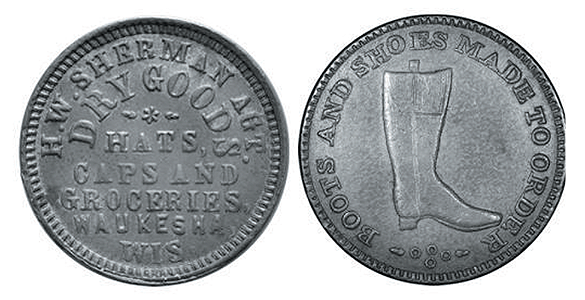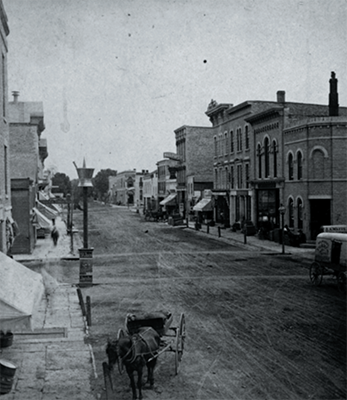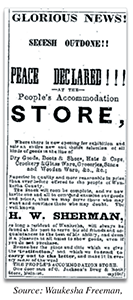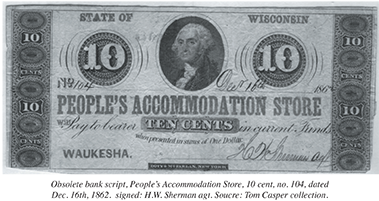
NOW Articles Written By Members
A look back at a common, but classic commemorative – Wisconsin’s Territorial Centennial
A side-tracked story: Mardi Gras Doubloons
A look back at a collecting specialty – the O.P.A. ration tokens of WWII
Bullion And Coin Tax Exemption – Act Now!
Is There A Twenty Cent Piece We Can Add To A Collection
Capped Bust Half Dollars: A Numismatic Legacy
U.S. Innovation Dollars: Our Most Under-Collected Coin?
My 2023 ANA Summer Seminar Adventure
In defense of the American Women's Quarters
A look back in numismatic history – the Hicksville Silver Dollar Hoard
The proofs so few of us collect: Jefferson Nickels
A look back in numismatic history – a story too good to be true
Kilroy promotes war bond sales
Just passing through a short-lived bank
The Kewaunee Line Encased Coin Folder
Lyman C. Draper: Collector, Historian, Genealogist
>> More articles in the Archive
For more NOW Articles Written By Members,
<< More articles in the Archive
The People’s Accommodation Store
[by Randy Raikes #2137]
Just one token can lead you to a hidden treasure. I was walking the floor of the Waukesha Coin Show when I found a dealer I’ve had luck with in the past. He had a Civil War token from Waukesha, Wisconsin, a city west of Milwaukee and my home town. It had a symbol of a boot on one side and H.W. Sherman -- Dry Goods, Hat, Caps and Groceries, Waukesha Wisconsin on the other side.

During the Civil War, merchants used tokens and bank scripts due to the lack of coinage. People hoarded gold, silver and even copper coins in the beginning years of the war. The Federal government had not issued enough currency so merchants were forced to issue privately made tokens that became accepted as a replacement currency, usually worth one cent. These Civil War tokens are known as Civil War store cards and usually have a standard picture on one side (reverse) and the merchant’s promotion on the other (obverse).1
I’m a fairly new collector and this was my first exposure to Civil War store cards and thought it was neat to see one from Waukesha. I walked back over to the other side of the hall, looking at other coins and then lit hit me (that feeling you probably know as a collector)... I had to have that token. It was from Waukesha and part of my hometown’s history. What was the story behind it and who was H.W. Sherman? I felt a strange anxiety that someone had purchased the token. I had to get there before it was gone. I hustled back to the dealer. It took all the money that I had with me, but it was worth it. So began my search for H.W. Sherman and his store.
* * *
Henry W. Sherman came to Waukesha County Wisconsin in the 1840’s from New Haven Connecticut. His brother Andrew T. Sherman had settled Genesee Township, in Waukesha County, in 1841 at the age of 20 while Henry would have been 24 years old.2 Henry came from family well known in American history. He is a son of Charles Sherman and Jennet Taylor. Charles served as Colonel during the War of 1812, having charge of the coast defenses between New Haven and New London. His father, John Sherman, was a grandson of Hon. Roger Sherman, one of the signers of the Declaration of Independence.3
Census records show Henry Sherman worked as a clerk and then as a merchant in 1850 and 1860, respectively.4 At age 43, Henry opened his own store. The May 13, 1862 Waukesha Freeman announced:
“ANOTHER CANDIDATE FOR PUBLIC FAVOR – The store recently occupied by C. Cork, has been rejuvenated, and is now being fi lled with a fi ne stock of Dry Goods, Boots and Shoes, Crockery, &c. It is termed ‘The People’s Accommodation Store’ and is under the management of that prince of good fellows H. W. Sherman. We predict for the New Store, a good business, and to its patrons, good goods at low figures.”
The first ad for the People’s Accommodation Store appeared in the following week’s Freeman, May 20th. Henry’s ad states his store is located “one door east of C. Jackson’s Drug & Book Store, Main-st.” I’ve attempted to find a photo of Henry’s store.
An 1854 photo of Main street Waukesha shows an awning one store past C. Jackson’s Drug & Book store identifi ed by the “giant mortar” sign on the right side of the street. I assume this to be the C. Cork store that Henry took occupancy of.

About 1854, Main St.. Waukesha looking east towards Five Points. C.Cork’s store awning just beyond mortar sign. (center of photo). Source: John Schoenknecht collection.
The People’s Accommodation Store ads appear in the Freeman from May 20, 1862 to January 13, 1863. They read as follows:
“Glorious News! Secesh Outdone!! Peace Declared !!! At The People’s Accommodation Store, Where there is now opening for exhibition and sale and entire new and choice selection of all kinds of goods in the line of Dry Goods, Boots & Shoes. Hats & Caps, Crockery & Glass Ware, Groceries, Stone and Wooden Ware, &c, &c; Superior in quality and more reasonable in price than ever before offered to the people of Waukesha County. The Stock will soon be complete, and we now invite one and all to come and examine our goods and prices that we may serve those who may want and convince those who may doubt. The well known H.W. Sherman, so long a resident of Waukesha, will always be found at his post to serve, his old friends and acquaintances to the best of his ability, and deem it a pleasure at all times to show goods, even if you do not purchase. Remember the place and title which we give the ‘institution,’ and which we intend to carry out to the letter, and make it in every sense of the word THE PEOPLE”S ACCOMMODATION STORE. One door east of C. Jackson’s Drug & Book Store, Main-st.”
 Around the Summer of 1862, the United States was completely coinless. Businesses had paper script printed, typically in values of 3, 5, 10 , 25, and 50 cents to be used to buy goods and services.5
Around the Summer of 1862, the United States was completely coinless. Businesses had paper script printed, typically in values of 3, 5, 10 , 25, and 50 cents to be used to buy goods and services.5
Source: Waukesha Freeman, Henry issued such notes. They can be found today but are fairly rare. It’s estimated only five exist of each denomination.6
I found a few collectors with early large type notes and interestingly they had the words “or Currency” written on the note after goods. These notes were issued as No.1 and No.5. I’m assuming Henry added the words since the handwriting is similar to his signature. All the notes that I found with dates on them, small type, ranging from numbers 20 to 142 were signed in December of 1862.7
At this time the city of Waukesha had about 2,086 residents and was growing. The going wage for a harvest hand was $1.50 per day.8 A dozen eggs cost 13 cents. And the Waukesha Freeman newspaper published every Tuesday cost $1.50 for a year subscription.9
Henry also issued tokens or store cards. He would have ordered them sometime in 1862 to early 1863 from a die sinker named Lanphear from Cleveland, Ohio.10 There are three known Civil War Store Cards from Waukesha, Wisconsin: J.A. Dunbar, Charles Cork and Henry W. Sherman Agt. They all sold groceries and dry goods.

The H.W. Sherman store card has a symbol of a boot on one side and on the reverse “H.W. Sherman Ag.t / Dry Goods / Hats, / Caps and / Groceries, / Waukesha, /Wis.” It is listed by FULD as 930C-1a. It is considered somewhat rare as an estimated 20-74 exist. Compared to Dunbar’s and Cork’s with 20-74 and 10-20 respectively.1
Two years after opening the store, a partnership between C. Jackson and Henry Sherman regarding the People’s Accommodation Store was dissolved on June 27, 1864 and the announcement stated “entire stock of goods will be sold at unprecedentedly low figures.”11 Shortly afterwards, on Sept 6, 1864 a young townsman R. L. Gove leases Sherman’s store and announces he is filling it with a “choice assortment of boots and shoes.”12 I found a photograph of Main street from 1870 that shows the store east of C. Jackson’s with a sign: R L. Gove – Boots & Shoes. In a Sept 20, 1864 Freeman ad for R. L Gove’s store “People’s Boots and Shoe store” states its “Now Ready for Fall and Winter Trade” and references “Sherman’s Old Stand”.
The building next to C. Jackson’s has changed since H.W. Sherman occupied it. At one time replaced with a new building by the National Exchange Bank in 1893. 13 Today, at 311 W Main Street, the building is home to Art & Framing 123, a custom picture frame studio. Some remnants of the old bank structure are still there but overall it has been remodeled with a cream city brick exterior and a simple inviting front door. The C. Jackson building still stands as it did in the 1860’s. It now is Black Dragon Tattoo. You can lean against the exterior brick wall and envision horse drawn wagons pulling up to load supplies.
I learned a lot about Waukesha’s history and some of its early pioneers as I was researching my token. I find it amazing how much enjoyment one token can bring. I still have more to uncover about Henry Sherman and a few mysteries to solve. I’m still looking for a picture of his store. It’s like searching for hidden treasure.
References:
1) Fuld, George and Melvin, U.S. Civil War Store Cards, 2nd Ed. Quarterman Publishing, Lawrence, MA, 1975, pp. 1, 578
2) Album of Genealogy and Biography, Cook County, Illinois with Portraits 3rd ed. revised and extended (Chicago: Calumet Book & Engraving Co. 1895), pp. 18-20
3) Ancestry.com. U.S., Sons of the American Revolution Membership Applications, 1889-1970 [database online]. Provo, UT, USA: Ancentstry.com Operations, Inc., 2011
4) 1850; Census Place: Waukesha, Waukesha, Wisconsin, Roll: M432_1009; Page: 280B; Image: 90 and 1860; Census Place: Waukesha,Waukesha, Wisconsin; Roll: M653_1436; Page: 225; image 232, Family History Library Film: 805436
5) Q. David Bowers, “Landmark Events, Part 5” The Numismatist, July 2012, ANA p. 116
6) Wisconsin Obsolete Bank Notes & Script, Chester L. Krause 1994 p. 476.
7) Notes from contacted collectors and from the Eliasberg & Krause Collections - 3/2/2010 Lot 3307, Chester L. Krause Collection.
8) Waukesha Daily Freeman, Centennial Edition, 1859- 1959, Section A p. 10.
9) Waukesha Freeman, December 23, 1862, p. 2
10) Wisconsin Civil War Tokens, The Robert C. Kraft Collection, by Rich Hartzog, World Exonumia Press. 1991 p. 38
11) Waukesha Freeman, June 28, 1864 p. 2.
12) Waukesha Freeman, Sept. 6, 1864, p. 3.
13) Exchange Bank opened in 1882; Depression closed it, Waukesha Daily Freeman, Centennial Edition, 1859- 1959, Section L, p. 20.
Randy Raikes can be contacted at rraikes@wi.rr.com.
Have an interesting numismatic topic you’d like to share with your fellow NOW members?
Send your article to evan.pretzer@protonmail.com today!!!